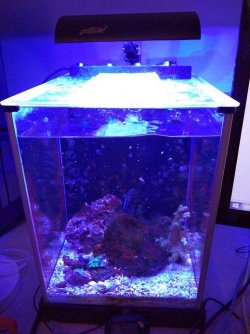Two words: Aiptasia bomb. Not much interesting going on outside of that unfortunately.
There are two main types of Aips I've run across on the gulf-cultured rock: one that tends to get very large as an individual and doesn't divide much (if at all) and another that is incredibly aggressive, stays small, multiplies like crazy, and even chokes out macro given the opportunity. I would be very surprised if these two variants are just different strains of the same species because of the day and night-like difference bewteen them, but when they are small I can't tell the difference. The large ones that are practically hosting-sized do look a little unusual though by the time they get that big.
Anyway, it's not the large ones in this tank. I ended up reintroducing the incredibly aggressive one into this tank at some point since January and haven't been set up to deal with it yet. The tank is going to have to be mostly drained again, scrubbed, and the rock replaced at least temporarly (have to dry the current one and re-culture) before the end of the summer, but I haven't gotten there yet. Then two more peps are going to go in again as a preventative measure to try to make sure there is no more of this. They had been moved out, which is part of what led to this. All of those nems are filtering the water - so the water is great lol. But it is an ungodly horror in every other way.
None of my other picos have been prone to this issue for some reason...I've got a 0.9gal with just hermits and snails that's kind of mucky looking because they constantly stir the sand, but not a single nem in it. Similarly, my 3gal mantis tank just has the one large Aip still (the type that never seems to split); none of this total takeover business.
By the way, word of warning...the initial explosion in this last round seemed to be specifically triggered by the use of Aip-X. I had maybe 10 individuals at most, went after a few, and then by the next morning morning, the treated nems had simply split themselves into 50billion nubs that ran all over the tank in the coming days. I saw basically the same problem with Aip-X in my 55 (and therefore gave up on it), but with peps in there it was a different story. Joes Juice never seems to allow that response and has worked great for me, but it also seems to be more caustic, so I don't trust using it in such a small volume of water. It has the strongest effect on the nems when allowed to linger and degrade on its own rather than being siphoned out, which means it could send the pH all over the place in a 1.5gal.
There are two main types of Aips I've run across on the gulf-cultured rock: one that tends to get very large as an individual and doesn't divide much (if at all) and another that is incredibly aggressive, stays small, multiplies like crazy, and even chokes out macro given the opportunity. I would be very surprised if these two variants are just different strains of the same species because of the day and night-like difference bewteen them, but when they are small I can't tell the difference. The large ones that are practically hosting-sized do look a little unusual though by the time they get that big.
Anyway, it's not the large ones in this tank. I ended up reintroducing the incredibly aggressive one into this tank at some point since January and haven't been set up to deal with it yet. The tank is going to have to be mostly drained again, scrubbed, and the rock replaced at least temporarly (have to dry the current one and re-culture) before the end of the summer, but I haven't gotten there yet. Then two more peps are going to go in again as a preventative measure to try to make sure there is no more of this. They had been moved out, which is part of what led to this. All of those nems are filtering the water - so the water is great lol. But it is an ungodly horror in every other way.
None of my other picos have been prone to this issue for some reason...I've got a 0.9gal with just hermits and snails that's kind of mucky looking because they constantly stir the sand, but not a single nem in it. Similarly, my 3gal mantis tank just has the one large Aip still (the type that never seems to split); none of this total takeover business.
By the way, word of warning...the initial explosion in this last round seemed to be specifically triggered by the use of Aip-X. I had maybe 10 individuals at most, went after a few, and then by the next morning morning, the treated nems had simply split themselves into 50billion nubs that ran all over the tank in the coming days. I saw basically the same problem with Aip-X in my 55 (and therefore gave up on it), but with peps in there it was a different story. Joes Juice never seems to allow that response and has worked great for me, but it also seems to be more caustic, so I don't trust using it in such a small volume of water. It has the strongest effect on the nems when allowed to linger and degrade on its own rather than being siphoned out, which means it could send the pH all over the place in a 1.5gal.




